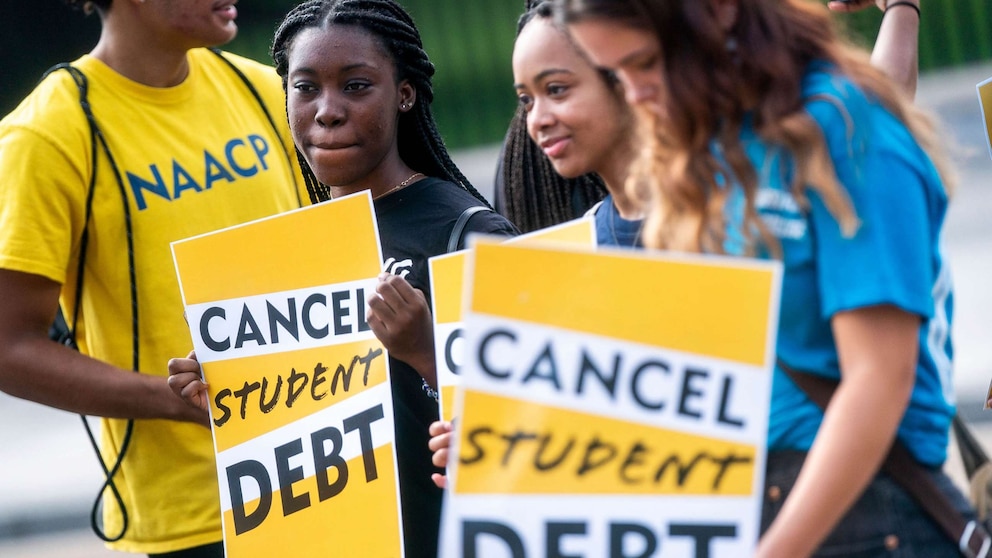Trump's Student Loan Order: Impact On Black Borrowers

Table of Contents
Limited Access to Loan Forgiveness Programs Under Trump's Administration
During the Trump administration, several student loan forgiveness programs existed, including Income-Driven Repayment (IDR) plans and the Public Service Loan Forgiveness (PSLF) program. However, eligibility requirements often created significant barriers for Black borrowers. These programs, while aiming to provide relief, were frequently structured in ways that inadvertently disadvantaged those already facing systemic challenges.
-
Income-Driven Repayment (IDR) Plan limitations: IDR plans offered lower monthly payments based on income, but often resulted in longer repayment periods and ultimately higher total interest paid. Black borrowers, disproportionately facing lower incomes due to systemic inequities in employment and wealth accumulation, were less likely to benefit substantially.
-
Public Service Loan Forgiveness (PSLF) program restrictions and low success rates for Black borrowers: The PSLF program, designed to forgive loans after 10 years of public service employment, had extremely stringent eligibility requirements. Navigating these requirements proved challenging for many, and the program's success rate was already low. This was exacerbated for Black borrowers, who might have had less access to jobs that qualified for PSLF due to systemic barriers in employment.
-
Lack of targeted initiatives to address historical inequities in access to higher education and subsequent loan burdens: The Trump administration lacked targeted programs specifically designed to address the historical disadvantages faced by Black students in accessing higher education and managing the resulting debt. This absence of targeted initiatives further widened the existing gap in loan repayment and forgiveness.
Impact of Income-Driven Repayment (IDR) Plans on Black Borrowers
Income-Driven Repayment (IDR) plans, while intended to make student loan payments more manageable, presented unique challenges for Black borrowers. The design of these plans, while seemingly beneficial, often failed to adequately address the deeper systemic issues contributing to the disparity in student loan debt.
-
The impact of lower income levels on affordability of IDR plans: Even with reduced monthly payments, Black borrowers, often facing lower incomes, still struggled to afford even the reduced payments. This often led to delinquency and further financial hardship.
-
Potential for longer repayment periods and increased total interest paid: While lower monthly payments offered temporary relief, the extended repayment periods under IDR plans resulted in significantly higher total interest paid over the life of the loan. This increased the overall debt burden for Black borrowers.
-
Challenges in navigating the complexities of IDR plan enrollment and maintenance: The application processes for IDR plans were complex and required significant understanding of financial regulations. Many Black borrowers lacked access to the financial literacy resources needed to effectively navigate these processes, further hindering their ability to access relief.
The Role of Predatory Lending Practices and Historical Disparities
The disproportionate student loan debt burden on Black borrowers isn't solely a consequence of recent policies. Historical and ongoing predatory lending practices and systemic racism have played a significant role.
-
Higher interest rates and less favorable loan terms for Black borrowers: Historically, Black borrowers have been targeted with higher interest rates and less favorable loan terms compared to their white counterparts, increasing their overall debt burden.
-
Lack of access to financial literacy resources: Limited access to financial literacy resources has left many Black borrowers unprepared to navigate the complexities of student loan repayment and forgiveness programs.
-
The impact of systemic racism on access to higher education and financial stability: Systemic racism has historically limited access to quality education and well-paying jobs for Black Americans, contributing to a higher reliance on student loans and a greater difficulty in repayment.
Comparison with Biden's Student Loan Policies (Optional)
In contrast to the Trump administration's approach, President Biden's student loan policies have included a greater emphasis on targeted relief for specific demographics, including measures aimed at addressing historical inequities.
-
Biden's emphasis on targeted relief for specific demographics: Biden's plans included provisions for targeted debt cancellation for specific groups, aiming to directly address the disproportionate burden on marginalized communities.
-
Changes in eligibility criteria for forgiveness programs: Biden's administration has made changes to eligibility criteria, aiming to make forgiveness programs more accessible and inclusive.
-
Increased funding for financial literacy and outreach programs: Increased funding has been allocated to financial literacy programs, aiming to empower borrowers with the knowledge needed to navigate the complex student loan system.
Conclusion
Trump's student loan orders had a complex and often detrimental impact on Black borrowers. Limited access to forgiveness programs, the challenges of IDR plans, and the legacy of predatory lending and systemic racism all contributed to the disproportionate burden of student loan debt on this community. Understanding the full impact of Trump's student loan policies on Black borrowers requires continued research and engagement. Stay informed about updates and advocate for equitable solutions to address the student loan debt crisis impacting Black borrowers. Addressing this crisis demands a comprehensive approach that tackles both current policies and the long-standing systemic inequities that perpetuate this disparity.

Featured Posts
-
 Ftc To Appeal Microsoft Activision Merger Decision
May 17, 2025
Ftc To Appeal Microsoft Activision Merger Decision
May 17, 2025 -
 Brace For A Credit Score Drop The Impact Of Missed Student Loan Payments
May 17, 2025
Brace For A Credit Score Drop The Impact Of Missed Student Loan Payments
May 17, 2025 -
 Angel Reeses Fiery Rebuttal To Chrisean Rock Interview Criticism
May 17, 2025
Angel Reeses Fiery Rebuttal To Chrisean Rock Interview Criticism
May 17, 2025 -
 Josh Cavallos Courageous Journey Kicking Down Walls In Football
May 17, 2025
Josh Cavallos Courageous Journey Kicking Down Walls In Football
May 17, 2025 -
 Josh Alexander Discusses Don Callis Aew And His Wrestling Path On 97 1 Double Q
May 17, 2025
Josh Alexander Discusses Don Callis Aew And His Wrestling Path On 97 1 Double Q
May 17, 2025
Latest Posts
-
 Djokovic Gap Alcaraz O Ban Ket Miami Open 2025 Phan Tich Nhanh Dau
May 17, 2025
Djokovic Gap Alcaraz O Ban Ket Miami Open 2025 Phan Tich Nhanh Dau
May 17, 2025 -
 Kortlarin Efendisi Novak Djokovic
May 17, 2025
Kortlarin Efendisi Novak Djokovic
May 17, 2025 -
 Djokovic Va Alcaraz Chung Nhanh Ban Ket Miami Open 2025
May 17, 2025
Djokovic Va Alcaraz Chung Nhanh Ban Ket Miami Open 2025
May 17, 2025 -
 Djokovic Yine Zirvede Tenis Duenyasinin Krali
May 17, 2025
Djokovic Yine Zirvede Tenis Duenyasinin Krali
May 17, 2025 -
 Dokovicev Uticaj Mensik Otkriva Bez Tebe Ni Ja Ne Bih Bio Ovde
May 17, 2025
Dokovicev Uticaj Mensik Otkriva Bez Tebe Ni Ja Ne Bih Bio Ovde
May 17, 2025
